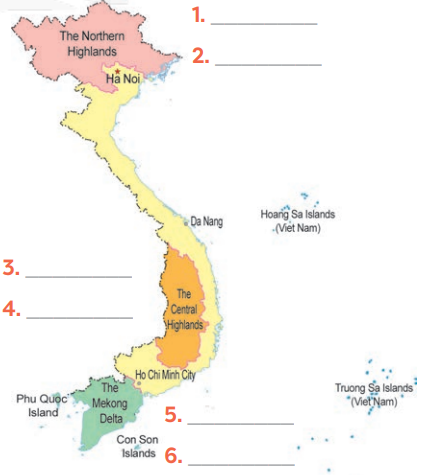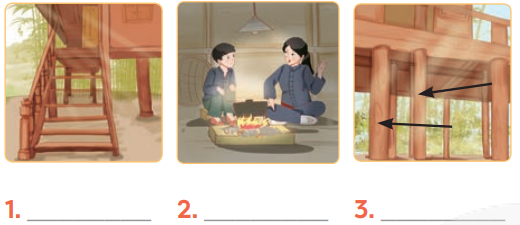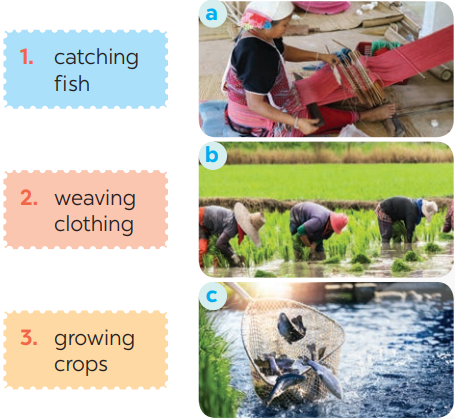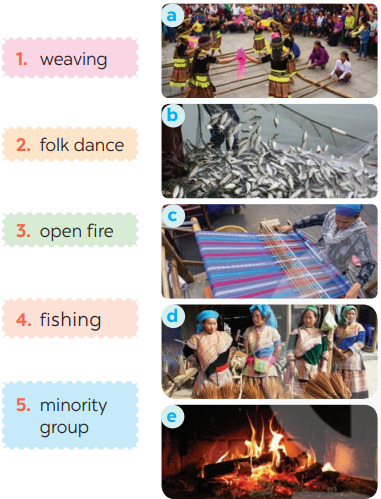Giải SGK, SBT Unit 4. Ethnic groups of Vietnam Global Success
Giải SGK, SBT Unit 4 Global Success
4. Complete the sentences with the words and phrases from the box.
(Hoàn thành các câu với các từ và cụm từ trong hộp.)
|
overlooks traditional folk dance ethnic groups musical instrument |
1. I love mua sap, a popular _____ of the Thai people.
2. Their beautiful stilt house _____ a large rice field.
3. A: What is the name of a popular Tay’s _____?
B: It’s dan tinh.
4. Every ethnic group has their own _____ culture.
5. Of the 54 _____ in Viet Nam, the Kinh is the largest.
Vocabulary
1. Write a word or phrase from the box under each picture.
(Viết một từ hoặc cụm từ từ hộp dưới mỗi hình ảnh.)
|
Rong house |
bamboo flute |
gong |
|
terraced fields |
weaving |
wooden statue |
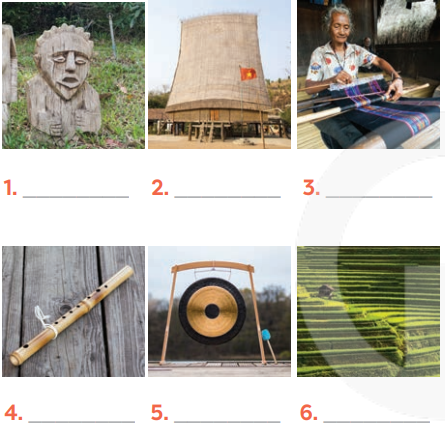
2. Match the words and phrases with their meanings.
(Nối các từ và cụm từ với ý nghĩa của chúng.)
|
1. minority group |
a. the animals we keep on a farm like cows and sheep |
|
2. livestock |
b. a large room for community activities |
|
3. gardening |
c. a group smaller in size than other groups in the same country |
|
4. gong |
d. a traditional musical instrument |
|
5. communal house |
e. work like growing, watering, weeding, and harvesting |
3. Complete the sentences with the words and phrases from the box.
(Hoàn thành các câu với các từ và cụm từ trong hộp.)
|
communal house |
raise |
unique features |
|
weave |
minority group |
livestock |
1. It’s interesting to learn about the _____ of an ethnic group's traditional culture.
2. Most mountain girls know how to _____ clothing.
3. The Cham in Ninh Thuan _____ sheep and cows.
4. A _____ is for community meetings and events.
5. There are fewer Nung than Kinh, so they are an ethnic _____.
6. Children in both the lowlands and highlands help raise their family’s _____.
Countable and uncountable nouns
(Danh từ đếm được và không đếm được)
3. Write C (countable) or U (uncountable) for the underlined words.
(Viết C (đếm được) hoặc U (không đếm được) cho các từ được gạch chân.)
|
Some minority (1) groups are farmers. They do not have much (2) land and they use simple farming techniques. After finding an (3) area for a garden, the men cut the (4) trees down and burn them. The (5) ash they collect helps enrich the soil. They then grow a few (6) crops like rice and corn. |
1. _____ 2. _____ 3. _____ 4. _____ 5. _____ 6. _____ |
Speaking
4. Work in pairs. Discuss and tick (✓) the features of a stilt house from the list below. Share your opinions with the class.
(Làm việc theo cặp. Thảo luận và đánh dấu (✓) các tính năng của một ngôi nhà sàn từ danh sách dưới đây. Chia sẻ ý kiến của bạn với cả lớp.)
A stilt house ____________.
|
has a flat cement roof |
|
|
stands on big posts |
|
|
is made from natural materials |
|
|
has a modern toilet |
|
|
is a flat in a big block |
|
|
is close to nature |
|
2. Listen and tick (✓) the activities that minority children do to help their families.
(Nghe và đánh dấu (✓) những hoạt động mà trẻ em dân tộc thiểu số làm để giúp đỡ gia đình.)
|
1. look after the house (trông nhà) |
|
|
2. weave clothing (dệt vải) |
|
|
3. prepare food (chuẩn bị đồ ăn) |
|
|
4. build houses (xây nhà) |
|
|
5. grow crops (trồng nông sản) |
|
|
6. raise livestock (chăn nuôi gia súc) |
|
2. Complete the sentences with the word and phrases from the box.
(Hoàn thành các câu với từ và cụm từ trong hộp.)
|
folk songs communal house staircase musical instruments sticky rice |
1. Minority groups have their own ______ like the dan tinh, gong, t’rung.
2. The Kinh use ______ to make banh chung and banh tet.
3. For most minority groups like the Bahnar and Ede, the ______, usually known as Rong house, is the heart of the village.
4. My grandmother taught me to sing many ______.
5. The ______ of a Muong’s stilt house has an odd number of steps: 5, 7, or 9.
4. There is one incorrect underlined word in each sentence. Circle and correct it.
(Có một từ gạch chân sai trong mỗi câu. Khoanh tròn và sửa lại cho đúng.)
|
|
Correct word |
|
1. A big stilt houses stands on high posts. |
|
|
2. The Lahu build their houses from wood and wild banana leave. |
|
|
3. Much people in remote areas travel on foot. |
|
|
4. Most minority women weave clothes and do houseworks. |
|
|
5. In the mountains, there is not many land for growing crops. |
|



